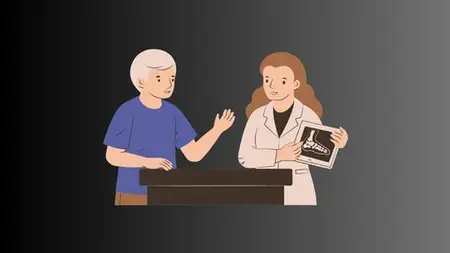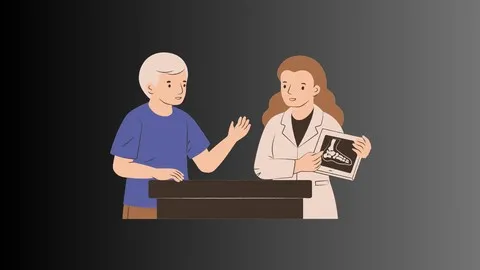Radiology X-Ray Of Ankle And Foot
Published 2/2025
MP4 | Video: h264, 1920x1080 | Audio: AAC, 44.1 KHz
Language: English | Size: 396.61 MB | Duration: 2h 45m
Published 2/2025
MP4 | Video: h264, 1920x1080 | Audio: AAC, 44.1 KHz
Language: English | Size: 396.61 MB | Duration: 2h 45m
Comprehensive Guide to Foot and Ankle X-Rays: Views, Anatomy, variants ' pathology and Fracture Classification"
What you'll learn
Understand the standard radiographic views of the foot and ankle, including AP, lateral, mortise, and specialized projections.
Identify normal anatomy, accessory ossicles, and common anatomical variations.
Recognize fractures, dislocations, and injury classifications such as Weber, Lauge-Hansen, and Lisfranc fractures.
Diagnose common pathologies, including avascular necrosis, stress fractures, and tarsal coalitions.
Apply a systematic approach to interpreting X-rays, ensuring accurate assessment and diagnosis
Requirements
Basic understanding of human anatomy, particularly the musculoskeletal system.
Some familiarity with medical imaging, especially X-ray interpretation, is helpful but not required.
Suitable for medical students, radiology residents, orthopedic surgeons, podiatrists, and healthcare professionals interested in foot and ankle radiography.
No prior radiology experience is necessary—this course will cover fundamental concepts and progress to advanced topics.
A willingness to learn and apply a systematic approach to reading foot and ankle X-rays.
Description
X-Ray Radiography of the Foot and AnkleAccurately interpreting foot and ankle X-rays is essential for diagnosing fractures, dislocations, and other pathologies. This comprehensive course provides a structured approach to reading and analyzing foot and ankle radiographs, making it ideal for radiologists, orthopedic surgeons, emergency physicians, podiatrists, and other healthcare professionals.What You’ll Learn:Standard radiographic views, including AP, lateral, mortise, stress, and weight-bearing projections.Detailed anatomy of the foot and ankle, including bones, joints, and common anatomical variations.Identification of normal accessory ossicles and their clinical significance.Recognition of common fractures and dislocations, including Weber, Lauge-Hansen, Maisonneuve, Lisfranc, and Jones fractures.Evaluation of soft tissue injuries, overlooked fractures, and subtle radiographic findings.Systematic checklists for AP mortise and lateral views to ensure accurate assessment.Understanding of key pathological conditions such as avascular necrosis, tarsal coalition, stress fractures, and posterior impingement syndrome.Who Should Take This Course?Radiology residents and medical students looking to strengthen their X-ray interpretation skills.Orthopedic surgeons, podiatrists, and emergency physicians who assess foot and ankle injuries.Physiotherapists and sports medicine specialists managing musculoskeletal conditions.Radiologic technologists seeking to expand their knowledge of foot and ankle imaging.This course is designed to take you from fundamental concepts to advanced interpretation techniques, providing a clear and systematic approach to foot and ankle radiography. Whether you're a beginner or an experienced practitioner, this course will enhance your diagnostic confidence and clinical decision-making.Enroll today and take your foot and ankle X-ray interpretation skills to the next level.
Overview
Section 1: Introduction
Lecture 1 Introduction
Section 2: Ankle positions
Lecture 2 AP view
Lecture 3 Mortise view
Lecture 4 Lateral view
Lecture 5 Stress views
Lecture 6 Calcaneus views
Section 3: Foot views
Lecture 7 Standard views
Lecture 8 DP view
Lecture 9 Medial oblique and lateral view
Lecture 10 Weight bearing views
Lecture 11 Toes view
Section 4: Ankle anatomy
Lecture 12 Lateral view 1
Lecture 13 Lateral view 2
Lecture 14 Syndesmosis
Lecture 15 Normal anatomy
Lecture 16 AP mortise
Lecture 17 Ankle spaces
Lecture 18 Calcaneus
Lecture 19 Anatomy calcaneus
Lecture 20 Zonal anatomy
Lecture 21 Midfoot
Lecture 22 Foot bones
Section 5: Normal variants and pitfalls
Lecture 23 Normal accessory ossicles
Lecture 24 Stieda process
Lecture 25 Posterior impingement syndrome
Lecture 26 Navicular ossicles
Lecture 27 Os tibiale externum
Lecture 28 5th metatarsal
Lecture 29 Calcaneal apophysis
Lecture 30 Hallaux sesamoid
Lecture 31 Epiphyseal cleft
Lecture 32 Tarsal coalition 1
Lecture 33 Tarsal coalition 2
Lecture 34 Accessory soleus muscle
Lecture 35 Calcaneal lesions
Section 6: Traumatic conditions of ankle and foot
Lecture 36 Overlooked injuries
Lecture 37 AP mortise checklist
Lecture 38 Lateral view checklist
Lecture 39 Ankle fracture
Lecture 40 Fracture malleolus
Lecture 41 Weber classification
Lecture 42 Lauge Hansen classifications
Lecture 43 Maisseunnauve #
Lecture 44 Pilon # midfoot classification
Lecture 45 Calcaneus #
Lecture 46 Talar #
Lecture 47 ICL of talus
Lecture 48 Navicular #
Lecture 49 Cuboid #
Lecture 50 Metatarsal #
Lecture 51 5th metatarsal and Jones #
Lecture 52 Stress #
Lecture 53 Lisfranc#
Lecture 54 Chopart #
Lecture 55 Toes#
Lecture 56 Talar dislocation
Lecture 57 Toddler #
Lecture 58 AVascular necrosis
Lecture 59 Flat foot -pes cavus
Lecture 60 Fibular hemimelia
Lecture 61 Diaphyseal tibiofibular synostosis
Lecture 62 Trevor's disease
Lecture 63 Metatarsal adducts
Lecture 64 FCD_NOF
Lecture 65 Osteoid osteoma
Lecture 66 Tibia stress #
Lecture 67 Shin splints
Section 7: Answers
Lecture 68 Quiez answers
Medical students and radiology residents looking to improve their X-ray interpretation skills.,Orthopedic surgeons, podiatrists, and emergency physicians who frequently assess foot and ankle injuries.,Physiotherapists and sports medicine specialists interested in understanding radiographic findings for injury management.,Radiologic technologists seeking to enhance their knowledge of foot and ankle imaging.,Any healthcare professional involved in diagnosing or treating foot and ankle conditions using X-rays



